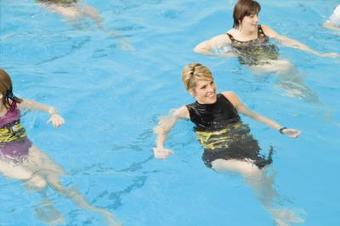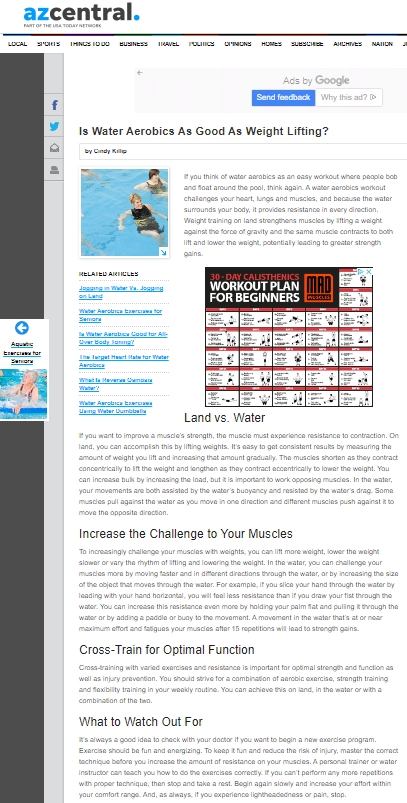
Originally published on AZCentral
If you think of water aerobics as an easy workout where people bob and float around the pool, think again. A water aerobics workout challenges your heart, lungs and muscles, and because the water surrounds your body, it provides resistance in every direction. Weight training on land strengthens muscles by lifting a weight against the force of gravity and the same muscle contracts to both lift and lower the weight, potentially leading to greater strength gains.
Land vs. Water
If you want to improve a muscle’s strength, the muscle must experience resistance to contraction. On land, one way you can accomplish this by lifting weights. It’s easy to get consistent results by measuring the amount of weight you lift and increasing that amount gradually. The muscles shorten as they contract concentrically to lift the weight and lengthen as they contract eccentrically to lower the weight. You can increase bulk by increasing the load, but it is important to work opposing muscles. In the water, your movements are both assisted by the water’s buoyancy and resisted by the water’s drag. Some muscles pull against the water as you move in one direction and different muscles push against it to move the opposite direction.
Increase the Challenge to Your Muscles
To increasingly challenge your muscles with weights, you can lift more weight, lower the weight slower or vary the rhythm of lifting and lowering the weight. In the water, you can challenge your muscles more by moving faster and in different directions through the water, or by increasing the size of the object that moves through the water. For example, if you slice your hand through the water by leading with your hand horizontal, you will feel less resistance than if you draw your fist through the water. You can increase this resistance even more by holding your palm flat and pulling it through the water or by dragging a paddle, kickboard, or buoy through the water. A movement in the water that’s at or near maximum effort and fatigues your muscles after 15 repetitions will lead to strength gains.
Cross-Train for Optimal Function
Cross-training with varied exercises and resistance is important for optimal strength and function as well as injury prevention. You should strive for a combination of aerobic exercise, strength training and flexibility training in your weekly routine. You can achieve this on land, in the water or with a combination of the two.
What to Watch Out For
It’s always a good idea to check with your doctor if you want to begin a new exercise program. Exercise should be fun and energizing. To keep it fun and reduce the risk of injury, master the correct technique before you increase the amount of resistance on your muscles. A personal trainer or water instructor can teach you how to do the exercises correctly. If you can’t perform any more repetitions with proper technique, then stop and take a rest. Begin again slowly and increase your effort within your comfort range. And, as always, if you experience lightheadedness or pain, stop.
References
- Journal of Strength and Conditioning Research: A Method for Monitoring Intensity During Aquatic Resistance Exercises
- Journal of Sports Science and Medicine: Physiological Assessment of Head-Out Aquatic Exercises in Healthy Subjects: A Qualitative Review
- Journal of Applied Physiology: Two Weeks of High-Intensity Aerobic Interval Training Increases the Capacity for Fat Oxidation During Exercise in Women
Author Bio
Cindy Killip is a medical exercise specialist, health coach, author and speaker who has been teaching and writing about exercise and wellness since 1989. She authored the book Living the BONES Lifestyle: A Practical Guide to Conquering the Fear of Osteoporosis [2012]. Killip received certifications as a medical exercise specialist, health coach, personal trainer, and group fitness instructor through the American Council on Exercise, and degrees in communications and sociology from Trinity University with a focus on pre-med and exercise science/lifetime fitness. She studied exercise physiology at the University of New Mexico graduate school.

Article as originally published is available to read on AZCentral at http://healthyliving.azcentral.com/water-aerobics-good-weight-lifting-19735.html



